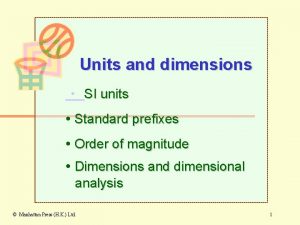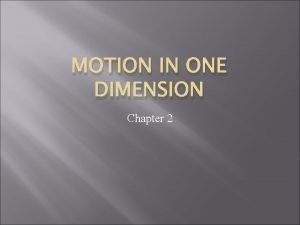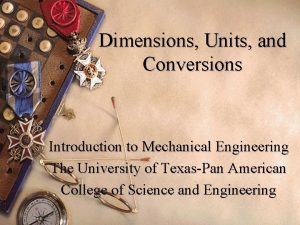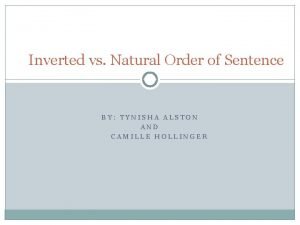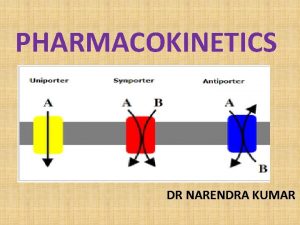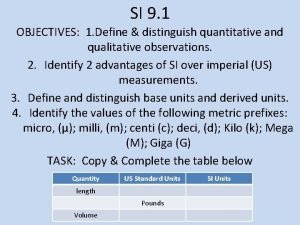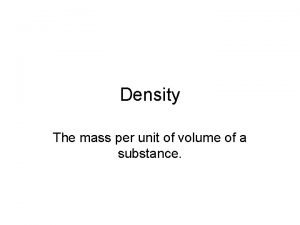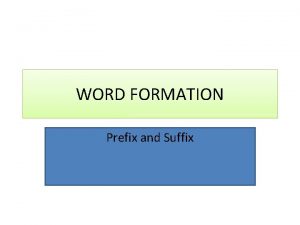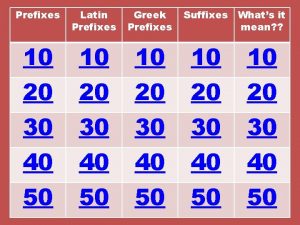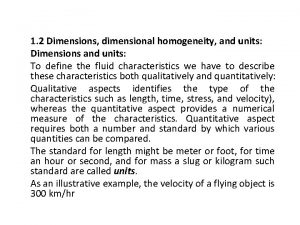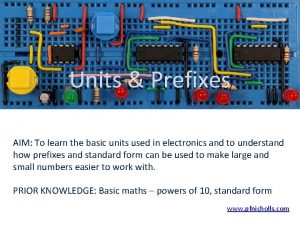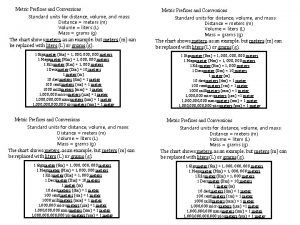Units and dimensions SI units Standard prefixes Order




















- Slides: 20

Units and dimensions • SI units • Standard prefixes • Order of magnitude • Dimensions and dimensional analysis © Manhattan Press (H. K. ) Ltd. 1

Units and dimensions (SB p. 4) What is Physics? What is “Physics”? • Study of basic characteristics of matter • Search for patterns or rules for the behaviour of objects in the Universe © Manhattan Press (H. K. ) Ltd. 2

Units and dimensions (SB p. 4) Major area Mechanics Major concern The study of motion and force Electricity and Magnetism The study of electric fields, magnetic fields, and their interactions Waves The study of waves Atomic Physics The study of the structure and behaviour of atoms The study of the nucleus of atoms The study of matter in solid and liquid states 3 Nuclear Physics Condensed© matter Manhattan Press (H. K. ) Ltd. Physics

Units and dimensions (SB p. 5) Units and dimensions Quantities that can be measured – physical quantities e. g. length, mass, time, weight, electric current, force, velocity and momentum To measure a physical quantity, a standard size of that quantity is required. This standard size is known as the unit for that particular physical quantity. Go to © Manhattan Press (H. K. ) Ltd. More to Know 1 4

Units and dimensions (SB p. 5) SI units 1. Base units The units for the basic physical quantities are known as base units. 7 basic physical quantities: length, mass, time, electric current, temperature, amount of substance and luminous intensity © Manhattan Press (H. K. ) Ltd. 5

Units and dimensions (SB p. 6) 1. Base units Basic quantity Length (l) Mass (m) Time (t) Electric current (I) Temperature (T) Amount of substance (n) Luminous intensity (Iv) © Manhattan Press (H. K. ) Ltd. Name of unit metre kilogram second Symbol of unit m kg s ampere kelvin mole A K mol candela Cd 6

Units and dimensions (SB p. 7) 2. Derived units A derived quantity is a combination of various basic quantities. Units for derived quantities are known as derived units. Go to More to Know 2 © Manhattan Press (H. K. ) Ltd. 7

Units and dimensions (SB p. 7) 2. Derived units Derived quantity Area Volume Frequency Mass density Name of unit Symbol of unit square metre m 2 cubic metre m 3 hertz Hz (s-1) kilogram per kg m-3 cubic metre Speed, velocity metre per m s-1 second Angular velocity radian per rad s-1 second Acceleration metre per m s-2 second squared © Manhattan Press (H. K. ) Ltd. 8

Units and dimensions (SB p. 8) Standard prefixes Very large or very small numbers, using prefixes Fraction 10 -1 10 -2 10 -3 10 -6 10 -9 10 -12 Prefix deci centi milli micro nano pico 10 -15 femto © Manhattan Press (H. K. ) Ltd. Symbol Fraction Prefix Symbol d 10 deka da c 102 hecto h m 103 kilo k 106 mega M n 109 giga G p 1012 tera T f 1015 peta P 9

Units and dimensions (SB p. 8) Order of magnitude The order of magnitude is the approximation of the value in the power of 10. Actual value Speed of car Speed of light 20 m s-1 (2 x 101 m s-1) 3 x 108 m s-1 Order of magnitude 101 108 The speed of light is higher than that of the car by an order of 107. © Manhattan Press (H. K. ) Ltd. 10

Units and dimensions (SB p. 9) Dimensions and dimensional analysis Dimension – relationship between physical quantity and basic quantities Physical Unit quantity Area m 2 Velocity m s-1 Acceleration m s-2 Force N = kg m s-2 Work J = kg m 2 s-2 © Manhattan Press (H. K. ) Ltd. Dimension L x L = L 2 L/T = L T-1/T = L T-2 M L 2 T-2 11

Units and dimensions (SB p. 9) Dimensions and dimensional analysis The dimension of an equation is said to be homogeneous if all the terms in it have the same dimensions or units. Dimensional analysis – method to check whether a physical equation is homogeneous Go to More to Know 3 © Manhattan Press (H. K. ) Ltd. Go to Example 1 Example 2 12

End © Manhattan Press (H. K. ) Ltd. 13

Units and dimensions (SB p. 5) Physical quantities can also be divided into basic physical quantities and derived quantities. We will learn about these later. Return to © Manhattan Press (H. K. ) Ltd. Text 14

Units and dimensions (SB p. 5) Unit for pressure Pressure = Force / Area [Pa] = [kg m s– 2] / [m 2] ∴ 1 Pa = 1 kg m– 1 s– 2 Return to © Manhattan Press (H. K. ) Ltd. Text 15

Units and dimensions (SB p. 10) Dimensional analysis is only considered as a first step to prove whether an equation is correct. Return to © Manhattan Press (H. K. ) Ltd. Text 16

Units and dimensions (SB p. 10) Q: For temperatures close to 0 K, the specific heat capacity (c) for a particular solid is given by c = a. T 3, where T is its temperature and a is a constant. What is the unit for a (in terms of the base units in SI)? Solution © Manhattan Press (H. K. ) Ltd. 17

Units and dimensions (SB p. 10) Solution: Unit for specific heat capacity (c) = J kg-1 K-1 = (N m) kg-1 K-1 = (kg m s-2) m kg-1 K-1 = m 2 s-2 K-1 From c = a. T 3 Return to a= Unit for a = Text = m 2 s-2 K-4 © Manhattan Press (H. K. ) Ltd. 18

Units and dimensions (SB p. 11) Q: The length l, Young modulus (E) and density (ρ) of a tuning fork determine its period (T). Which of the following equations is / are homogeneous? (a) T = (b) T = (c) T = where y is a constant and g is the acceleration due to gravity. Given that the unit for Young modulus (E) is kg m– 1 s– 2. Solution © Manhattan Press (H. K. ) Ltd. 19

Units and dimensions (SB p. 11) Solution: Unit for period (T) = s (a) Unit for =s The equation is homogeneous. (b) Unit for =s The equation is homogeneous. (c) Unit for = m 2 s-1 The equation is not homogeneous. © Manhattan Press (H. K. ) Ltd. Return to Text 20
 Prefixes for standard
Prefixes for standard Via optica
Via optica Dimensions and units
Dimensions and units Engineering dimensions and units
Engineering dimensions and units Gearless vs geared elevator
Gearless vs geared elevator Waste container lid
Waste container lid Root word dyna
Root word dyna Standard error definition
Standard error definition Standard language slideshare
Standard language slideshare Standard costing characteristics
Standard costing characteristics Botox dosage forehead
Botox dosage forehead Absorption costing income statement
Absorption costing income statement Inverted sentence to natural order
Inverted sentence to natural order Explain law of mass action
Explain law of mass action Metaboloism
Metaboloism First and second order change in education
First and second order change in education Law is order and good law is good order
Law is order and good law is good order First order cybernetics and second order cybernetics
First order cybernetics and second order cybernetics 7 fundamental units
7 fundamental units The standard metric units of density are:
The standard metric units of density are: Word building prefixes
Word building prefixes
